

Australia Facts for Kids. Australia Facts Australia for Kids Here are some interesting Australia Facts which were chosen and researched by kids especially for kids.
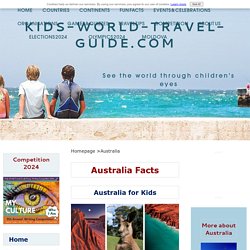
Name: Commonwealth of AustraliaGovernment: DemocracyPopulation: About 25.5 million (2021)Urban Population: 90%Capital: Canberra with 462,000 people (2021)Language: EnglishUnemployment: 12%Currency: 1 Australian dollar ($) = 100 centsReligion: mainly ChristiansTimezones: 3National Symbols: Golden wattle (flower), opal (gemstone), green and gold (colours) and the Commonwealth Star (a seven-pointed star)National Animals: Kangaroo, emuNational Holiday: 26 January (Australia Day)National Anthem: Advance Australia Fair. Australia. 101 Facts About Australia. Angloinfo. Education in Australia is internationally recognised as being of a very high standard.
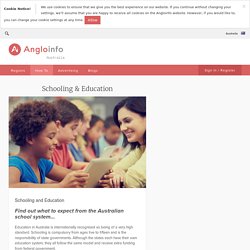
Schooling is compulsory from ages five to fifteen and is the responsibility of state governments. Although the states each have their own education system, they all follow the same model and receive extra funding from federal government. Education for Foreigners in Australia The Australian government provides public schools that are free of charge to residents of Australia. However, pupils that are in Australia on a temporary visa may have to pay school fees. As the school year (January to December) in Australia differs from many other countries, new arrivals to Australia should bring school reports and a reference from the previous school. More information on the Australian Education System from studyinaustralia.gov.au Overview of the Australian School System Education can start from aged three onwards, although this is not compulsory. Australia Map / Map of Australia - Facts, Geography, History of Australia. Australia whose name comes from the Latin word australis, meaning "southern", has a population of 23,480,939 and gained its independence in 1918.
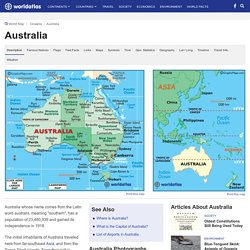
The initial inhabitants of Australia traveled here from far-southeast Asia, and from the Torres Strait islands. From their initial settlements in the north some 70,000 years ago, their individual lifestyles and cultural traditions eventually spread across this vast uncharted land. The first European exposure to Australia occurred in 1606, when the Dutch explorer, Willem Janszoon, sighted, then landed on the Cape York Peninsula. He found the area inhospitable and moved on. Regardless, adventurers and traders, aggressively searching for riches in the southern hemisphere, continued to sail through the northern coastal areas bordering a land the Dutch named New Holland.
In 1688, on one of his three circumnavigations of the globe, William Dampier became the first British explorer to set foot on Australian land, coming ashore in Shark Bay. School education. Australia Country Profile. City WebQuests: Sydney: history and traditions. This webquest will help you investigate Sydney: its history, music and famous landmarks.
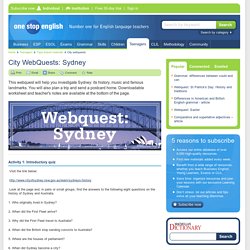
You will also plan a trip and send a postcard home. Downloadable worksheet and teacher's notes are available at the bottom of the page. Activity 1: Introductory quiz. Australia & New Zealand. Sydney - kidcyber. Sydney is the largest city in Australia.

About 5 million people live in the city and its suburbs. It is the capital city of the state of New South Wales. Sydney in Australia is built around beautiful Sydney Harbour. The harbour covers an area of 5 500 hectares and has an average depth of 9 metres. The famous harbour bridge (it was opened in 1932) and the opera house (opened in 1973) are tourist attractions there. The city was named after Thomas Townshend, the first Viscount Sydney, who was an English politician involved in managing the colony of New South Wales. The city is run by a city council which is elected by the people of Sydney. The weather in Sydney is temperate which means it is rarely very hot or very cold. Visit Australia – Travel & Tour Information – Tourism Australia. Australia country profile. Australia ranks as one of the best countries to live in the world by international comparisons of wealth, education, health and quality of life.
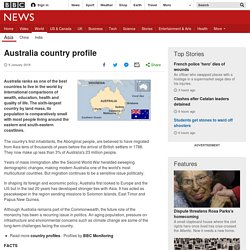
The sixth-largest country by land mass, its population is comparatively small with most people living around the eastern and south-eastern coastlines. The country's first inhabitants, the Aboriginal people, are believed to have migrated from Asia tens of thousands of years before the arrival of British settlers in 1788. They now make up less than 3% of Australia's 23 million people. Years of mass immigration after the Second World War heralded sweeping demographic changes, making modern Australia one of the world's most multicultural countries. But migration continues to be a sensitive issue politically.
In shaping its foreign and economic policy, Australia first looked to Europe and the US but in the last 20 years has developed stronger ties with Asia. Read more country profiles - Profiles by BBC Monitoring Prime Minister: Malcolm Turnbull. Eslteacher- Most important English speaking Countries. Australia - the land down under. Australia Theme - Lesson Plans, Thematic Units, Printables, Worksheets. Trapped - Australian TV Series s01e01.